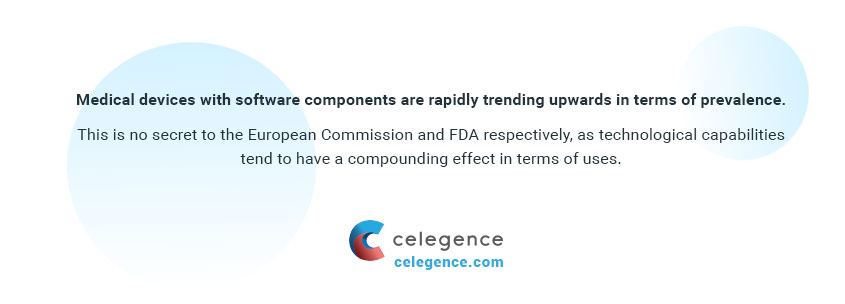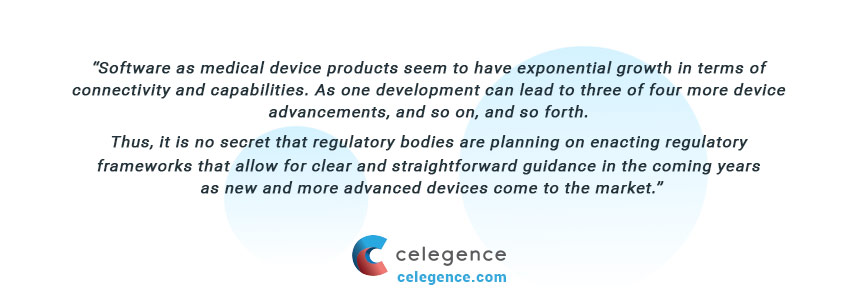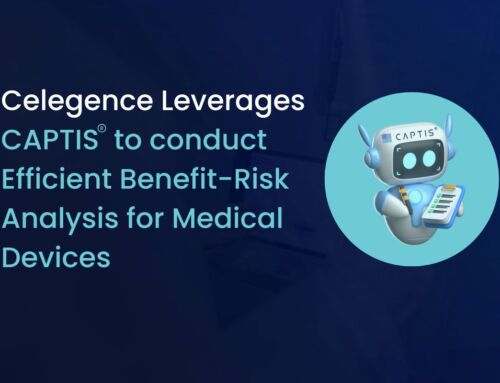
Software as a Medical Device SaMD at a Glance
Software as a Medical Device (SaMD) is the fastest evolving type of medical device on the market. With a rise in interconnected and ‘smart’ devices, they are rapidly growing in global presence. There is a wide range of intended uses for these devices, including measuring blood pressure, monitoring respiratory issues, and circulatory problems, all without the patient being confined to a hospital bed. This trend will only escalate, as many legacy devices will soon be upgraded to more advanced versions with software as an active part in their design. According to a recent Business Wire report, there is expected to be a Compound Annual Growth Rate (CAGR) of over 20% in SaMD device sales over the next seven years. Since there is demand, there certainly will be greater resources allocated to research and development for SaMDs.
The regulations for SaMD products have been a point of emphasis for industry experts, manufacturers, and notified bodies alike. Celegence has previously expanded on the topic, examining the parameters and classifications while highlighting the key take-a-ways for these device manufacturers. You can read the regulatory challenges for SaMD here.

Industry Prevalence of Software as a Medical Device (SaMD)
Medical devices with software components are rapidly trending upwards in terms of prevalence. This is no secret to the European Commission and FDA respectively, as technological capabilities tend to have a compounding effect in terms of uses. Agile development involving verification and validation testing, followed by continuous real-world data collection and learning human factors has led software components to provide continual loop data to healthcare providers thereby improving treatment decision making. Further, advancements in SaMDs promote the independence of patients fighting long term ailments and illnesses.
Additionally, software is becoming abundantly used as add-ons for legacy devices. Having the ability to adapt many proven devices with software is just another reason why the European Commission has decided to update many of the regulations. In what has been the most large-scale update of medical device regulations in decades, it is no secret why the EU MDR has prioritized software in its regulations.

Claim Your Free EU MDR Checklist Now!
Make sure you and your business are compliant with the new EU MDR. Get our 23 page checklist for actionable technical documentation requirements.
Reclassifications that are Reflective of SaMD Trends
Much of the classification guidance for software has to do with its intended purpose. This area of regulation desperately needed more in-depth directives. The sheer amount of new intended purposes has far exceeded the volume of regulatory updates from the EU. Not only have intended purposes expanded greatly, but also the ability to assist in the decision-making process mandates further directives from regulatory authorities in this space. For example, software that supplies information to assist in making decisions regarding diagnostic or therapeutic purposes will now be Class IIa. There is one important exception to this rule though, i.e..if the pending decision has the potential to cause death or an extreme irreversible health issue of the patient will be classified as Class III.
Another area that saw proportional expansions to their regulations, is the elevated risk of the software due to rise in software capabilities and functionality. To this point, Class IIb will include devices that could cause serious deterioration of the patient’s health but are not irreversible. Devices that simply monitor the anatomical processes of a patient will be Class IIa but will be classified as IIb if the process being monitored could result in immediate danger to the patient of the measurements stray too far.
One last area of interest for the industry is SaMD devices that involve a transfer of energy between the device and the patient. These types of devices have developed extremely quickly, but even so, their complete medicinal potential has certainly not been realized. As such, Rule 9 of the regulation governs devices that are intended to exchange or administer energy, which will be Class IIa. Further, these devices will be classified as IIb if the process by which the energy is transferred is potentially hazardous. Additionally, Rule 10 of the same Annex states that devices that are intended to “monitor and diagnose” will be class IIa if energy is absorbed by the body from the device. Devices such as these would be upgraded to class IIb if the device monitors a parameter that could be potentially life threatening (central nervous system, respiratory issues, and cardiac activity).
For complete guidance on SAMD, explore here.
Challenges with SaMD
While the feedback loop for SaMDs drives innovation and faster product iteration, the industry also faces a fundamental challenge on examining how to develop a product for a fast-changing, ever-evolving “internet of everything” world while demonstrating continued patient safety, clinical efficacy, and adhering to regulatory compliance?
One of the best ways for companies to address this includes continued notified body and IRB involvement for high-risk devices while enabling a faster feedback loop including, risk-based software segregation, development of the software involving formative human factors coupled with real-world performance analytics, and an effective clinical validation and quality management system.

Industry Perspective from Celegence Medical Device Regulatory Consultant
Software as medical device products seem to have exponential growth in terms of connectivity and capabilities. As one development can lead to three of four more device advancements, and so on, and so forth. Thus, it is no secret that regulatory bodies are planning on enacting regulatory frameworks that allow for clear and straightforward guidance in the coming years as new and more advanced devices come to the market.
From everything I’ve heard from individuals at cutting edge, and major device manufacturers, is that the key trend is connectivity, and their diagnostic implications. Additionally, a major driver in SaMD development is the rise of smartwatches. Not only are they generally affordable, they offer a convenient, and even stylish tool to monitor a variety of health metrics. While medical uses were not likely to have been the impetus for smartwatch developments, they have effectively altered medical device capabilities forever.

Claim Your Free EU MDR Checklist Now!
Make sure you and your business are compliant with the new EU MDR. Get our 23 page checklist for actionable technical documentation requirements.
Summary – SaMD and the EU MDR
The changes that are being ushered in now with regards to Software as a Medical Device, and the rate of ongoing technological advancement, means that SaMD is not just going to be a regulatory concern for the short term but more than likely for the long term. Medical device manufactures need to be aware of their requirements and obligations with regards to SaMD and we are happy to provide our clients with that expertise.


